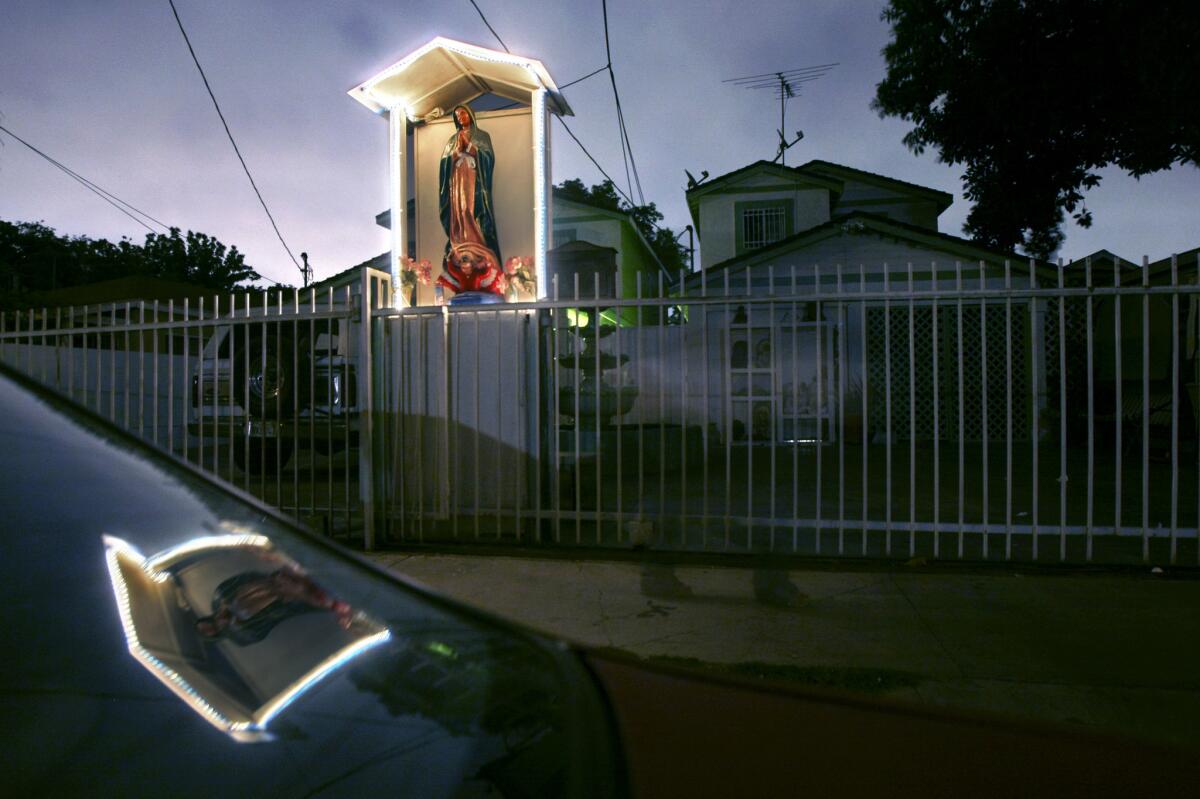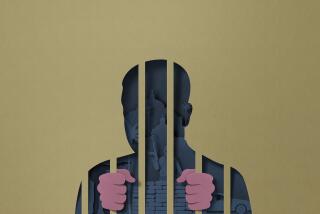The strands of the Sinaloa drug cartel web

Gabriel Dieblas Roman took orders from cartel bosses in Mexico, hard men who ruled by fear, but he wouldn’t approve a shipment without talking to a plucky, middle-aged woman from Compton.
Guadalupe “Lupita” Villalobos ran a storefront botanica where Virgin of Guadalupe statuettes sat beside grinning Saint Death skeletons. She would threaten to turn neighbors into toads, and her clients believed she could divine the future by studying snail shells scattered on a tabletop.
Roman, a client, called her one day for advice on an important matter.
Sounding anxious about a pending cocaine shipment to the East Coast, he asked Villalobos to “give it a little look.”
“When is it leaving?” Villalobos asked.
“Tomorrow,” Roman said.
A rattling sound came over the phone, then the jangle of objects spilling on a hard surface.
“Well, everything is normal,” Villalobos told Roman.
But she wasn’t finished.
“Be careful, there is surveillance,” she said.
Be wary of a young gordito, a chubby guy. “It seems that he has trouble with the police.”
Roman knew who she meant.
“That son of a bitch is worse than a parrot,” he said.
The L.A. hub
The Sinaloa cartel, Mexico’s most powerful organized crime group, has its version of a corporate headquarters in gaudy mansions and hilly estates that dot the state of Sinaloa. But its U.S. distribution hub sits 1,000 miles northwest, in the immigrant neighborhoods that line the trucking corridors of Southern California.
Drugs move from Colombia to Mexico, then across the Imperial Valley to stash houses and staging areas around Los Angeles. There, scores of distribution cells take over, packaging the cocaine and concealing it in tractor-trailers headed across the United States.
As one of dozens of transportation coordinators for the cartel, Roman bought tractor-trailers, hired drivers and arranged for loads of frozen chickens as cover. He received the drugs from Eligio “Pescado” Rios, who operated a string of stash houses.
Together they formed part of a pipeline that extended across the country to a distributor living near Yankee Stadium in New York.
The shipments were relatively small, from 300 to 600 pounds, to reduce losses in the event of a seizure. Yet the drip-drip-drip of the Rios-Roman pipeline was believed to deliver a ton of cocaine a month to the Northeastern U.S.
Neither man was getting rich. Roman drove an old Ford Mustang, Rios a banged-up white truck he called “La Paloma” (The Dove).
Roman’s family lived in a tiny house in the high-desert town of Hesperia. Rios rented a room atop a garage in Paramount. Neither flashed weapons or had serious rap sheets.
They were like hundreds of other modestly paid workers — truckers, money couriers, load coordinators — who kept the drug supply chain humming. Rios and Roman had something else in common: Both were very superstitious.
They relied on psychics to guide their operations, and they gave them a cut of the profits. The psychics provided advice on timing. Cartel psychics have also been known to put curses on law enforcement officers, “cleanse” stash houses, perform elaborate candle-lighting ceremonies or smear goat entrails across floors.
The strange rituals and breathless divinations were overheard by agents of the Drug Enforcement Administration investigating a major distribution network of the Sinaloa cartel. The probe had been dubbed Imperial Emperor, after a suspect named Kaiser, German for “emperor.”
DEA agents in Los Angeles also took inspiration from their suspects. Rios’ nickname, Pescado, means “fish” in Spanish. They dubbed their piece of the case Psychic Catfish.
Bust in Paramount
On March 1, 2006, Rios received a call from Carlos “Charlie” Cuevas, one of the cartel’s lead smugglers on the California-Mexico border. Cuevas was arranging a large cocaine delivery from Mexico that night. The shipment would arrive in three Chevrolet Avalanches at the Rosewood restaurant in Paramount, southeast of Los Angeles.
Rios drove to the diner and took a seat. DEA agents waited nearby in parked cars. They had been tracking him and eavesdropping on his phone calls for weeks.
One of his stash houses was a few blocks away, on 1st Street in Paramount. Two of his brothers lived there. On weekends, they grilled carnitas on the patch of front lawn and cranked up their brassy Sinaloa music like any other family in the immigrant neighborhood. Inside, the only furnishings were a few mattresses and a television.
Rios used a toolbox built into the bed of his truck to move drugs from his stash houses to staging areas: warehouses or homes with double lots that could accommodate tractor-trailers. Mechanics and packers moved the cocaine to the trailers, taking hours to hide it in the guts of the refrigeration units. The trucks then left for the East Coast, with two drivers to keep them moving around the clock.
The different parts of the distribution system were strictly compartmentalized. Rios delivered the drugs to the staging area, but he was long gone by the time Roman arrived with the drivers. The two men had probably never met; all they knew was to follow orders from a man called Gato in Guadalajara, beyond the DEA’s reach.
At 8:30 p.m., the first Avalanche showed up at the Rosewood. Rios took the key and drove to the stash house on 1st Street. The wall between the garage and a bedroom had a large cutout to allow for quick unloading. Packers in the bedroom bundled and stacked the cocaine for shipment to the staging area.
Over the next few hours, two more Avalanches pulled into the parking lot. Each time, Rios drove the SUV to the stash house for unloading and returned to the restaurant. Then he went home.
At 4 a.m., police raided the house and found nearly 455 pounds of cocaine in neatly stacked packages. Rios’ brothers were arrested but he was not — a calculated move by the DEA.
To press charges against Rios, the DEA would have had to file a probable-cause affidavit revealing the wiretap operation. That would have alerted suspects across the U.S. and in Mexico that federal agents were listening in on their conversations.
The DEA had gone to great lengths to keep the investigation secret, enlisting local law enforcement agencies to make arrests and seizures, as with the Paramount bust.
Agents kept the nervous Rios under surveillance, hoping his phone chatter and movements would tell them more about cartel operations. They didn’t anticipate his next move: Rios fled to his home in Culiacan, Sinaloa, where he was promptly kidnapped by cartel enforcers.
The bust had cost the cartel about $3.3 million, and powerful people were upset. In Sinaloa, Rios was tied up and beaten over several days, leaving behind a mattress stained with his blood.
Getting desperate
Roman, a failed truck driver with a sixth-grade education, licked his upper lip when he was nervous. By mid-2006, he had ample reason to be.
In recent months, truckers linked to him had been arrested in Missouri, New Jersey, Atlanta and Oklahoma, each with more than 220 pounds of cocaine. Another trucker was caught with $3.5 million in cash. Each of the seizures was carried out by a different law enforcement agency.
Now Roman had lost his main supplier — Rios — along with the confidence of his bosses.
He spent hours working the phones, trying to arrange a shipment. He needed cash to support his two wives — one in California, one in Mexico — his 11 children and stepchildren and his pregnant mistress.
In times like these, he drove to Compton to visit Villalobos at her home. Perhaps she could break his streak of bad luck.
On one visit, Roman walked past the displays of carved wooden Indian busts near the garage as a DEA agent watched from a distance. A statue of the Virgin of Guadalupe was perched atop the security fence, sprinkled with penny and nickel offerings. There were pit bulls in the backyard, a pigeon coop in the front.
Mexican psychics have been known to rub white pigeons up and down a person to absorb negative forces before releasing the birds, and any evil, into the sky. They suggest herbal baths and sometimes add hallucinogenic morning glory seeds to teas they serve their clients.
Whatever Villalobos gave Roman, it appeared to be potent. He practically staggered out the front door and had to be helped into the car by his girlfriend.
By the fall, Roman had finally lined up a shipment. He called Villalobos, who scattered her snail shells.
She gave her blessing for the delivery, but with a warning. “Tell the chubby one to be careful.”
Intercepted
Three days later, Hildegardo Rivera, a driver for Roman who lived in the Central Valley farming town of McFarland, headed east in a tractor-trailer believed to be carrying cocaine.
Rivera was heavyset. It’s not known whether he was the man mentioned by the psychic, but he did indeed have troubles: The DEA was tracking his movements through the GPS device in his cellphone.
Six days after he left Southern California, Rivera’s cellphone showed him to be in Keasbey, N.J., where Roman’s drivers had been known to deliver cocaine and collect payment. Rivera switched phone numbers and the DEA lost track of him. Agents obtained a court order to track his new number, and by the time they resumed surveillance days later, he was heading back to California.
Agents tracked his progress through Pennsylvania, Maryland, West Virginia, Virginia and Tennessee. In Arkansas, Rivera stopped to pick up a load of frozen chickens.
When Rivera reached Arizona, agents in Los Angeles drove east to intercept him. One parked his unmarked car on the shoulder of Interstate 40 near Flagstaff.
The agent had never seen Rivera or his big rig. All he had to go on were DMV photographs of several of Roman’s suspected truckers.
A purple truck whooshed past with a plastic human skeleton plastered to its grill. A Halloween prank, the agent thought. More trucks passed.
When the agent called for Rivera’s latest location, he was surprised to hear that the truck was now west of him. The agent made a U-turn and sped back toward California.
He followed two trucks to a rest stop. Another check of the phone’s GPS signal placed Rivera close by.
The agent saw the purple truck with the skeleton on the front. A man who resembled the picture of Rivera got out of the cab. The agent notified the California Highway Patrol and took off.
The plan was for the CHP to intercept Rivera at an agricultural checkpoint just inside California. That way, the DEA’s cover wouldn’t be blown.
After pulling Rivera over, the CHP officer opened the door of the trailer. It looked empty. A drug-sniffing dog jumped inside.
DEA agents sitting in their cars a mile away waited anxiously. After 30 minutes, a CHP officer called. No drugs, he said, but the dogs had found 155 plastic-wrapped bundles hidden in the trailer’s ceiling panels.
Each contained about $20,000. The total seizure: $3.1 million.
No more help
The bust wiped out what little credibility Roman had left with his bosses. He was soon so broke he couldn’t pay his utility bills. His California wife lugged buckets around their dusty Hesperia neighborhood, asking for water.
On Dec. 5, 2006, Roman called Villalobos. He used to tip her as much as $2,000 for a $20 reading, but now he said he was penniless.
She offered no sympathy.
“Sometimes one digs one’s own grave,” the psychic said. “I am not going to continue with an ungrateful person.”
“Don’t be like that,” Roman responded.
He offered to show her the police report on the money seizure, proof that he wasn’t holding out on her.
She dismissed it. She didn’t care that he was broke now. She felt he had cheated her when times were good.
“Listen carefully to what I am going to tell you: How many years did we work together? How many trips did we make together? Seventeen trips?”
She went on: “With me helping, everything worked out perfectly for you.”
“That’s right,” Roman said.
“I was helping, made you boss of bosses. Where is the money?” she said. “You screwed me when you didn’t need me anymore.”
In May 2007, a federal grand jury in New York indicted Roman on cocaine-distribution and money-laundering charges. Among the potential witnesses: Lupita Villalobos.
Prosecutors flew her to New York, but she wouldn’t leave her hotel. They leaned on her to testify. She refused.
In the end, her cooperation wasn’t necessary. Roman pleaded guilty and was sentenced to 14 years.
Rios, the stash house operator who fled to Culiacan, re-entered the U.S., was arrested and pleaded guilty to conspiracy.
Rivera, the trucker, was accused of conspiracy, but the charge was dropped.
Villalobos was never charged. The psychic stuck to her story: She was a simple businesswoman trying to make a living.
“These people give me money and I tell them what they want to hear,” she said. “I don’t know the future.”
MORE: The players | Evidence, wiretaps and testimony | How the drug pipeline worked
Read Part One: Unraveling Mexico’s Sinaloa Cartel
Read Part Three: Clear skies and cocaine
Part Four: Showdown in Sinaloa
About this story
For several years, the U.S. Drug Enforcement Administration put the distribution side of Mexico’s Sinaloa cartel under a microscope. This series describes the detailed picture that emerged of how the cartel moves drugs into Southern California and across the United States. Times staff writer Richard Marosi reviewed hundreds of pages of records, including DEA investigative reports, probable-cause affidavits, and transcripts of court testimony and phone surveillance. He also interviewed DEA agents, prosecutors and local law enforcement officers serving on DEA-led task forces, as well as two cartel operatives convicted in the investigation.
More to Read
Sign up for Essential California
The most important California stories and recommendations in your inbox every morning.
You may occasionally receive promotional content from the Los Angeles Times.











